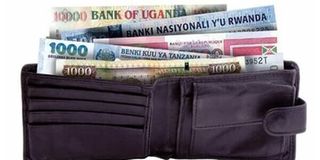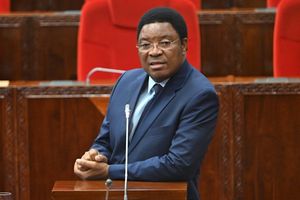Spotlight on free-falling East African currencies

What you need to know:
- To counteract the depreciating currencies, the EAC bloc needs to increase productivity and value addition in exports.
Arusha. Low productivity and import dependency are to blame for escalating depreciation of local currencies in East Africa.
“Our exports are less than the imports. This has put enormous pressure on the value of our currencies,” said a business leader.
To cushion the falling currencies, he opined, the East African Community (EAC) bloc needs to improve productivity and value addition of exports.
“We are import dependent yet our exports are less than the imports,” said John Bosco Kalisa, the executive director of the East African Business Council (EABC).
He was speaking to The Citizen on the recently released East Africa Economic Outlook 2023 by the African Development Bank (AfDB).
The report, which was launched last Thursday, was solid on the falling value of the currencies of EAC partner states to varying degrees.
Mr Kalisa, who participated in its launch through a video link, gave other reasons driving the currency depreciation.
They include growing public debts for both multilateral and bilateral funders to mega projects in the region.
Kenya, the largest economy in the region, bore the brunt of the falling value of the currency compared to its neighbours.
“It is easy to tell why. It is partly due to the impact of the recent elections and severe drought,” he pointed out.
Kenya also had the highest level of external debts against its Gross Domestic Product (GDP) compared to other EAC states.
“What do you expect of a country using 60 percent of its economic output (GDP) to service debts?” asked the CEO of the Arusha-based regional business body.
Kenyan shilling had until recently been popular among cross-border traders due to their strength and acceptability compared to other currencies.
According to the AfDB, the Kenyan shilling recorded a depreciation of 7.5 percent against the US Dollar from 109.5 in 2021 to 117.7 in 2022, making it one of the worst years for the currency.
The depreciation of Tanzania shilling against the US dollar was minimal, due to prudent monetary and fiscal policies, depreciating by 0.2 percent against the US dollar in 2022 due to a slowdown in exports. The Rwandan franc depreciated by 4.2 percent against the US dollar in 2022, going from 988.9 in 2021 to 1030.6 in 2022 due to a significant upswing in food, capital goods, and petroleum imports in 2022, which increased the demand for US dollars.
The South Sudanese pound depreciated by 75 percent against the US Dollar, from 309.4 in 2021 to 541.4 in 2022, the highest depreciation in the region.
The Uganda shilling depreciated by 2.9 percent against the US Dollar in 2022. Its value fell from 3562.2 against the US Dollar in 2021 to 3664.2 in 2022.
But as of yesterday, the Kenyan shilling traded at Ksh142 per US dollar while Tanzanian and Ugandan shillings traded at Sh2,400 and USh 3,600 respectively. In some bureau de change, however, the Tanzanian shilling is fetching between Sh2,510 and Sh2,610 depending on whether one was selling or buying it.
Rwanda, Burundi and DR Congo francs were exchanged at 1,200, 2,840 and 2,400 respectively per one US $.
The South Sudan Pound was selling at 130 for one US dollar. The South Sudanese currency has been described as “one of the worst-performing currencies in 2022”, by the report.
Rwanda registered impressive growth ahead of the seven countries in the EAC. The growth was driven by investments in the productive sector.
The tiny country, which joined the EAC in July 2007, has registered a 7.8 percent growth for 2022 also attributed to the involvement of the private sector.
Uganda’s economy has also been doing well. Mr Kalisa attributed this to the discovery of oil and gas which in turn attracted “a lot of investments”.
Tanzania is ranked third in economic performance of the East Africa Economic Outlook 2023, largely driven by tourism recovery.
“The tourism recovery in Tanzania has enormously surpassed the pre-Covid era. Tanzania has opened its economy to the world in various sectors,” he said.
EABC, an apex body of private sector associations in the region, has offered four solutions through which the region can slow down currency depreciation.
“We need to improve our level of productivity, especially with regard to food to feed our population rather than depending on imports,” he said.
The EAC bloc also needs to encourage and promote local and regional production of goods “with comparative and competitive advantage”.
The EABC boss hinted that the solution to the declining value of local currencies in the region partly lay with the EAC creating its basket currency.
This is a unit of the region’s currencies that is acceptable by all the seven partner states, especially in cross-border trade.
He also suggested the fast-tracking of the Pan African Payment System (PAPS) which he believed would reduce exchange rate losses.
Reached for comment, officials of the EAC secretariat pleaded for more time to digest the issue.
They, however, hinted that the reasons for the depreciation of the local currencies were always associated with insufficient exports.
The chair of the Arusha regional business chamber Walter Maeda said the depreciating value of the shilling was largely due to poor performance in foreign trade.
“Maybe we are not exporting enough. That is why our currency is losing value against the dollar”, he told The Citizen.
He implored Tanzanians to enhance agricultural production, especially the production of food to halt the sliding of shilling due to the import of food.
Reuben Mcharo, an agricultural expert, insisted that Tanzania and other EAC countries should shy away from exporting raw materials and should instead add value to their farm produce.




